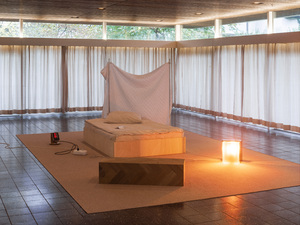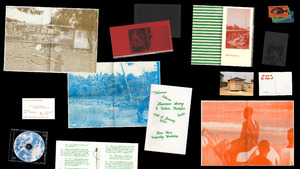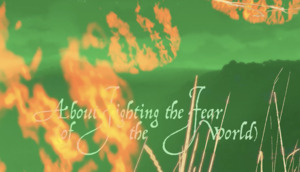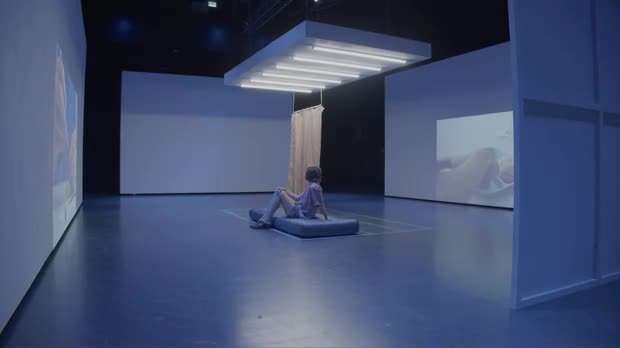Kommentierte Vorlesungsverzeichnisse
Benachbarte Sets (41)Alle Zusammenhänge anzeigen
Diese Sets wurden den gleichen Sets hinzugefügt wie das ausgewählte Set.
41 Inhalte
- Seite 1 von 4
Anything Besides a Bed
- Titel
- Anything Besides a Bed
- Autor/in
- Beschreibung (de)
- "Anything Besides a Bed" ist eine Kollektion bestehend aus sechs Arbeiten, die sich alle mit bestimmten Aspekten des Betts befassen: Schlafgewohnheiten, Dunkelheit und künstliches Licht, Lesen in und Reden über Betten, deren technologisches und digitales Umfeld sowie Privatsphäre, Intimität und Öffentlichkeit.
Jedes einzelne Objekt entsteht durch Beobachten, Vermischen, Austauschen und Kombinieren seiner kulturhistorischen, archäologischen, philosophischen oder sozialen Kontexte, gleichzeitig aber auch die Kontexte und formalen Aspekte der tatsächlichen Gegenstände, die im Umfeld eines Betts herum zu finden sind.
Daraus ergeben sich sechs Objekte, die nicht nur einfach eine Recherche und Analyse wiedergeben, sondern durch gewisse Interventionen in ihrer Form und Funktionsweise als nutzbares Möbel bzw. technisches Gerät zum Nachdenken anregen.
- "Anything Besides a Bed" ist eine Kollektion bestehend aus sechs Arbeiten, die sich alle mit bestimmten Aspekten des Betts befassen: Schlafgewohnheiten, Dunkelheit und künstliches Licht, Lesen in und Reden über Betten, deren technologisches und digitales Umfeld sowie Privatsphäre, Intimität und Öffentlichkeit.
- Beschreibung (en)
- "Anything Besides a Bed" is a collection consisting of six objects that all deal with certain aspects of the bed: sleep patterns, darkness and artificial light, reading and talking about beds, technological and digital environment as well as privacy and publicity.
Every individual object is conceived by observing, mixing, interchanging, and combining its contexts. These being the research aspects as well as the contexts of being actual objects and pieces of furniture that are found around the bed. The objects don’t just reflect their research but have their own purpose by being thought-provoking interventions in the way they look and are used.
- "Anything Besides a Bed" is a collection consisting of six objects that all deal with certain aspects of the bed: sleep patterns, darkness and artificial light, reading and talking about beds, technological and digital environment as well as privacy and publicity.
- Kategorie
- Typ des Projekts/Werks
- Schlagworte
- Datierung
- October 2023
- Dank an
- Moritz Appich
- Francesca Audretsch
- Massimiliano Audretsch
- Tim Bartel
- Vincent Carl Becher
- Nils Bergmann
- Jonathan Blaschke
- Sibylle Bläser
- Christoph Bläser
- Vanessa Bosch
- Oliver Boualam
- Richard Brunner
- Jules Buchholtz
- Felipe Carrión
- Sam Chermayeff
- Lukas Clark
- Céline Condorelli
- Ute Deutz
- Lizzy Ellbrück
- Lisa Ertel
- Marie Faaß
- Hanna Franke
- Taavi Hallimäe
- Teresa-Louise Häußler
- Susanne Heyer
- Matthias Holznagel
- Bruno Jacoby
- Chris Kabel
- Tobias Keilbach
- Barbara Zoé Kiolbassa
- Florian Knöbl
- Mio Kojima
- Julian Kuf
- Stefan Legner
- Lukas Marstaller
- Mona Mayer
- Isabel Motz
- Anne-Sophie Oberkrome
- Vlado Petrovic
- Barbara Polakova
- Johanna Schäfer
- Susanne Schmitt
- Waldemar Schwab
- Moritz Kamil Simon
- Wieki Somers
- Lorenz Stein
- Marcel Strauß
- Saskia van der Meer
- Leia Morgana Walz
- Jannis Zell
- Phil Zumbruch
- Sprache
- Material
- Abmessungen
- Mattress Multiplug Maße: 240 × 130 × 75 mm, Street Light Lamp Maße: 330 × 330 × 350 mm, Bedspread Curtain Maße: 2300 × 1800 mm / 350 × 350 × 1800 mm, Parquet Chest Maße: 1200 × 400 × 300 mm, Bedside Readings Maße: 109 × 75 × 108 mm, Sleep Timer Maße: 220 × 220 × 240 mm
- Ort: Institution
- Ort
- ZKM Pavillon
- Stadt
- Land
- Beteiligte Institution(en)
- Titel
- Anything Besides a Bed
- Projektleiter/in
- Semester
- Studiengang
- Typ der Abschlussarbeit
- Importiert am
- 05.11.2024
- Übergeordnete Sets
- 3
- Set enthält
- 0 7
A man in the shape of...
- Titel
- A man in the shape of...
- Titel (en)
- A man in the shape of...
- Autor/in
- Beschreibung (de)
- „A man in the shape of...“ ist eine von Calvin Kudufia realisierte Ausstellung, die Februar 2024 im Rahmen seines Diploms stattfand. In der Ausstellung beschäftigt sich Kudufia mit der metaphorischen Praxis des Sammelns und Verdichtens: „gathering time and binding it“, wie es die dänische Dichterin Inger Christensen in ihrem Gedicht „Alphabet“ (1981) formuliert hat. Scheinbar unzusammenhängende ‚Dinge‘ werden im Gedicht zusammengetragen und durch die einfache Verwendung eines einzelnen Wortes, des "Existierens" in Zusammenhang gebracht und bedeutsam gemacht. Allein die Geste des Zusammentragen und Benennens verstärkt ihre symbolische Kraft.
Durch einen losen Kontaktpunkt in 2019 begann Kudufias Recherche an der Sepulkralkultur der fantasy coffins, einem traditionellen Kunsthandwerk der Ga-Ethnie in Ghana. Die individuell gestalteten Särge folgen einem mündlich überlieferten Bildindex und sind stellvertretende Gefäße für das ins Jenseits übertretende Leben. Die ‚fantasy coffins‘ verhüllen nicht nur den physischen Körper, ihre Hülle trägt konkrete Spuren der in ihnen gefassten Existenz.
Wie alle Gefäße schirmen die ‚fantasy coffins‘ ihren Inhalt vor den Blicken der Umgebung ab. Im selben Moment dienen sie als repräsentativer Körper des Verstorbenen. Die Suche nach dem richtig geformten Gefäß, sei es ein Weidenkorb für Früchte, ein Buch für Worte oder im Fall der ‚fantasy coffins‘ ein Fischernetz für Fischer, stellt die Suche nach Signifikanz des eigenen Lebens dar: eine treffende Metapher für die Odyssee des Lebens.
In seiner Arbeit „A man in the shape of...“ macht Kudufia sein väterliches Haus in Tema (Ghana) zum physischen Ausgangspunkt seiner Recherche. In Form einer trans-medialen Erzählung wird dessen Essenz eingefangen und greifbar gemacht. Poetische Artefakte und Beobachtungen aus dem Alltag in Ghana werden sorgfältig arrangiert und dienen als Verdinglichung von Zeit. Sie dienen als greifbare Säulen von Kudufias Zeit in Ghana.
„A man in the shape of...“ trägt der angeborenen Sehnsucht nach einer konkreten geografischen Verankerung Rechnung. Kudufia nutzt die gesamte Ausstellung als metaphorischen Fingerzeig auf einen Ort auf der Landkarte.
In Form einer Audioübertragung, einer speziellen Sitzposition auf der Nachbildung eines traditionellen Hockers, referentiellen Bautechniken und einer Dreikanal-Videoinstallation wird diese geografische Verankerung konkret vermittelt. Durch die Untersuchung der Rolle von Ritualen bei der Gestaltung unseres Zugehörigkeitsgefühls, inspiriert durch die philosophischen Überlegungen von Byung Chul Han, bietet die Ausstellung ein Fenster zu einer Kultur, die gleichzeitig vertraut und fremd ist.
Im Mittelpunkt der Ausstellung steht eine Videoinstallation, die in sieben Abschnitte unterteilt ist. Die Aufteilung bezieht sich auf die Tradition der „one-week observation“ und beschreibt jeweils eine Facette von Kudufias persönlicher Reise. Das Video wird begleitet von einem Musikstück der ghanaischen Theatermacherin Edufa T. Sutherland, das mit der Unterstützung des Cellisten Ben Grocock gespielt und aufgenommen wurde. Das Video lässt Kudufias Erinnerungen, Fiktionen und Realitäten verschwimmen und vermischt dabei die Identitäten von Kudufia mit denen seines Vaters und Großvaters und lässt so ein komplexes Netz aus Zugehörigkeiten entstehen.
Eine Publikation, die integraler Bestandteil der Ausstellung ist, bedient sich der Form eines Gefäßes. Eine bedruckte Archivbox sammelt Kudufias Spuren auf seiner Suche nach den ‚fantasy coffins‘ und wird durch eine Hand voll ephemeraler Druckprodukte und Publikationen zum Dokumentationsapparat. Im Mittelpunkt der Archivbox steht ein Interview, zwischen Kudufia und dem Sargmacher Lawrence Anang in dessen Werkstatt in Teshie. Die einzige textliche Spur, die eine klare Verbindung zur Geschichte der Särge herstellt.
Das hölzerne Fundament einer nachgebauten Hütte dient als Sammelpunkt der Ausstellung und ermöglicht die Verbindung zwischen Druckerzeugnissen, Audio, Artefakten und den Betrachtenden. Die Kombination aus gesammeltem haptischen Material und audiovisuellen Arbeiten setzt sich zu einer transmedialen Collage zusammen, in der Kudufia die Geschichte seiner Verwurzelung auf intime Weise erzählt.
- „A man in the shape of...“ ist eine von Calvin Kudufia realisierte Ausstellung, die Februar 2024 im Rahmen seines Diploms stattfand. In der Ausstellung beschäftigt sich Kudufia mit der metaphorischen Praxis des Sammelns und Verdichtens: „gathering time and binding it“, wie es die dänische Dichterin Inger Christensen in ihrem Gedicht „Alphabet“ (1981) formuliert hat. Scheinbar unzusammenhängende ‚Dinge‘ werden im Gedicht zusammengetragen und durch die einfache Verwendung eines einzelnen Wortes, des "Existierens" in Zusammenhang gebracht und bedeutsam gemacht. Allein die Geste des Zusammentragen und Benennens verstärkt ihre symbolische Kraft.
- Beschreibung (en)
- "A man in the shape of..." is an exhibition realised by Calvin Kudufia, which took place in February 2024 as part of his diploma. In the exhibition, Kudufia deals with the metaphorical practice of "gathering time and binding it", as formulated by the Danish poet Inger Christensen. Through a trans-medial narration, the exhibition aims to capture the essence of his father's home in Tema (Ghana) and to make it tangible by carefully compiling poetic artefacts from the observed everyday life in Ghana.
Kudufia's research began with the so-called fantasy coffins, a traditional handicraft practiced by the Ga people of Ghana. The individually designed coffins follow an oral figurative index and are emblematic vessels for life passing into the afterlife. Not only do they conceal the physical body, but their shell bears imprints of the existence that preceded death. To give an example, the vessel of a fisherman might take the form of a boat or fishing net.
Similar to all vessels, they shield their content from its surroundings, simultaneously serving as a representation of the deceased to the eyes of the outside world. The search for the right-shaped vessel, be it a wicker basket for fruit or a book for words, mirrors the journey to discover one's own significance, as displayed figuratively by the fantasy coffins - an apt metaphor for the odyssey of life.
"A man in the shape of..." takes into account the innate longing for a concrete geographical rooting and uses the entirety of the exhibition as a metaphorical finger pointing to a place on the map. This geographical pinning is conveyed in the form of an audio transmission, a special seating position on a replica of a traditional stool, referential construction techniques and a three-channel video installation. By examining the role of rituals in shaping our sense of belonging, inspired by the philosophical reflections of Byung Chul Han, the exhibition offers a window into a culture that is both familiar and foreign at the same time.
At the heart of the exhibition is a video installation divided into seven segments referring to the tradition of the one-week observation, each describing a facet of Kudufia's personal journey. The video installation is accompanied by a musical piece composed by Edufa T. Sutherland, played and recorded with the assistance of cellist Ben Grocock. It blurs the boundaries between memory, fiction, and reality, inviting the viewer to reflect on the complexity of cultural identity and belonging.
The publication, an integral part of the exhibition, also takes the form of a vessel. Borrowing the shape of a printed archive box it collects Kudufia's traces on his search for the fantasy coffins and is conveyed through his graphic expression. At its center is an interview he conducted with coffin maker Lawrence Anang in his workshop in Teshie, the sole textual trace of the coffins' history.
In order to bring all of the pieces together, a wooden fundament of a hut serves as the gathering point of the exhibition, enabling the connection between printed matter, audio, artefacts, and the viewers.
The collected haptic material combined with the audiovisual pieces results in a trans-medial collage in which Kudufia intimately tells the story of his rooting.
- "A man in the shape of..." is an exhibition realised by Calvin Kudufia, which took place in February 2024 as part of his diploma. In the exhibition, Kudufia deals with the metaphorical practice of "gathering time and binding it", as formulated by the Danish poet Inger Christensen. Through a trans-medial narration, the exhibition aims to capture the essence of his father's home in Tema (Ghana) and to make it tangible by carefully compiling poetic artefacts from the observed everyday life in Ghana.
- Kategorie
- Typ des Projekts/Werks
- Schlagworte
- Datierung
- 22.02.2024
- Dank an
- Sprache
- Material
- Ort: Institution
- Ort
- Lichthof 04
- Stadt
- Land
- Titel
- A man in the shape of...
- Projektleiter/in
- Semester
- Studiengang
- Typ der Abschlussarbeit
- Importiert am
- 31.05.2024
- Übergeordnete Sets
- 2
- Set enthält
- 0 21
Absolvent:innen stellen ihre Arbeiten vor - alle Videos
- Titel
- Absolvent:innen stellen ihre Arbeiten vor - alle Videos
- Titel (en)
- Students introduce themselves and their work
- Titel
- Absolvent:innen stellen ihre Arbeiten vor - alle Videos
- Importiert am
- 31.07.2024
- Übergeordnete Sets
- 1
- Set enthält
- 0 3
About Fighting the Fear (of the World)
- Titel
- About Fighting the Fear (of the World)
- Titel (en)
- About Fighting the Fear (of the World)
- Autor/in
- Beschreibung (de)
- "Über das Bekämpfen der Angst (vor der Welt)" ist eine spekulative Videoarbeit, die ein Spektrum von Phänomenen rund um Karten, Angst, Krieg, Reisen und den Körper abdeckt, wobei der Schwerpunkt auf der Praxis der Kartierung als Instrument zur Unterdrückung und Kontrolle von Land und Menschen liegt. Das Video versucht, einen Rahmen für das Thema zu schaffen, indem es viele verschiedene Geschichten zu einem Cluster zusammenführt, der vielleicht nicht repräsentativ ist, aber einige Teile des Themas beleuchtet. Ästhetisch und strukturell ist das Video von Rollenspielen, der Pre-Vis-Technik (die in Filmproduktionen verwendet wird) und Found Footage inspiriert. Das Szenario ist in einer fernen Zukunft angesiedelt, in der Klimawandel und Massenaussterben längst ihre Auswirkungen gezeigt haben und die Bestien, die vor der großen Kolonisierung über das Unbekannte wachten, zurückgekehrt sind. In der Rolle der Hauptfigur sucht der Zuschauer, angeleitet von einem Erzähler, nach Überresten der alten Welt, um zu verstehen, warum alles kartiert werden musste.
- Beschreibung (en)
- "About Fighting the Fear (of the World)" is a speculative video work that covers a spectrum of phenomena around maps, fear, war, traveling, and the body, with a focus on the practice of mapping as a tool to oppress and control land and people. The video attempts to frame the issue by bringing together many different stories to create a cluster that may not be representative but illuminates some parts of the issue. Aesthetically and structurally, the video is inspired by role-playing games, pre-vis technique (used in film productions), and found footage. The scenario is set in a distant future in which climate change and mass extinction have long since had an impact and beasts that used to watch over the unknown before the big colonization have returned. As the main character, the viewer searches for remnants of the old world, guided by a narrator, in order to understand why everything had to be mapped.
- Typ des Projekts/Werks
- Schlagworte
- Datierung
- 22.02.2024
- Mitwirkende
- Dank an
- Sprache
- Untertitel (Film)
- Material
- Technik/Verfahren/Formate
- MP4
- Abmessungen
- 2500 x 1080 px
- Dauer
- 26 min
- Ort: Institution
- Ort
- Werkschau und Diplominstallation in Raum 222, Video-Screening im Kino im Blauen Salon
- Stadt
- Land
- Titel
- About Fighting the Fear (of the World)
- Projektleiter/in
- Semester
- Studiengang
- Typ der Abschlussarbeit
- Importiert am
- 28.02.2024
- Übergeordnete Sets
- 3
- Set enthält
- 3 3
7QM
- Titel
- 7QM
- Titel (en)
- 7sqm - inside views
- Untertitel
- Innen(an)sichten
- Autor/in
- Beschreibung (de)
- Was passiert, wenn Individuen in engen, geschlossenen Räumen mit kaum persönlicher, sondern standardisierter, fest verankerter, textilloser Ausstattung leben, in denen sie einer permanenten Überwachung und Kontrolle sowie streng geregelten Tagesabläufen ausgesetzt sind?
Mascha Dilger untersucht die Parameter sanktionierender Räume: Besuche in unterschiedlichen Justizvollzugsanstalten und Interviews mit ehemaligen Inhaftierten werden in der Rauminstallation 7qm - Innen(an)sichten verarbeitet. Realitäten eines vor der Gesellschaft verborgenen und von ihr verdrängten Ortes werden offengelegt.
Die Arbeit beleuchtet, wie aus einem fremdbestimmten, rasterartigen Alltag einer totalen Institution, Versuche der geistigen Flucht und der Selbstbestimmtheit hervorgehen können. Es werden ortsspezifische und subkulturelle Erscheinungsformen betrachtet, die als Überlebensstrategien zu verstehen sind.
- Was passiert, wenn Individuen in engen, geschlossenen Räumen mit kaum persönlicher, sondern standardisierter, fest verankerter, textilloser Ausstattung leben, in denen sie einer permanenten Überwachung und Kontrolle sowie streng geregelten Tagesabläufen ausgesetzt sind?
- Beschreibung (en)
- What happens when individuals live in narrow, confined spaces with hardly any personal but standardized, firmly anchored, textile-less furnishings, in which they are exposed to permanent surveillance and control as well as strictly regulated daily routines?
Mascha Dilger investigates the parameters of sanctioning spaces: visits to various prisons and interviews with former inmates are processed in the spatial installation "7qm - Innen(an)sichten". Realities of a place hidden from society are revealed.
The work illuminates how attempts of mental escape and self-determination can emerge from the grid-like everyday life of a total institution. Site-specific and subcultural manifestations are considered, which are to be understood as survival strategies.
- What happens when individuals live in narrow, confined spaces with hardly any personal but standardized, firmly anchored, textile-less furnishings, in which they are exposed to permanent surveillance and control as well as strictly regulated daily routines?
- Kategorie
- Typ des Projekts/Werks
- Schlagworte
- Datierung
- 11.07.2023 - 12.07.2023
- Mitwirkende
- Dank an
- Zaur Ahlimanov
- Phillip Banian
- Jeremias Beckford
- Sandra Blatterer
- Barbara Bohnen
- Matthias Bruhn
- Richard Brunner
- Céline Condorelli
- Hannah Cooke
- Jaya Demmer
- Lina Determann
- Nicola Dilger
- Susanne Dilger
- Alfred Dilger
- Manfred Döpke
- Nina Eberle
- Kerstin Eisenmenger
- Constanze Fischbeck
- Ebba Fransén Waldhör
- Laura Haak
- Uwe Habel
- Laurine Haller
- Igor Hardt
- Lina Höhne
- Lovis Iglinski
- Martina Kaltenbrunner
- Tobias Keilbach
- Alexander Knoppik
- Katja Koch
- Mikail Kolbasar
- Hanne König
- Susanne Kriemann
- Claudia Kröhl
- Barbara Kuon
- Alexia Metge
- Paulina Mimberg
- Ilja Morgenstern
- Leonie Mühlen
- Minh Anh Nguyen
- Luise Peschko
- Vlado Petrovic
- Milena Petrovic
- Tibor Pilz
- Christian Platz
- Paul Platz
- Waldemar Präg
- Corinne Riepert
- Thomas Rustemeyer
- Sebastian Schäfer
- Max Schäffer
- Philipp Schell
- Susanne Schmitt
- Mischa Schneider
- Waldemar Schwab
- Henriette Schwabe
- Manuel Sékou
- Alexander Theis
- Alexander Thelen
- Jan Tölle
- Lisa Tölle
- Lioudmila Voropai
- AStA
- Exit - Enter Life e.V.
- Badaue
- JVA Mannheim
- JVA Bühl
- Initiative „Faites Votre Jeu!“
- Sprache
- Material
- Ort: Institution
- Ort
- im großen Studio
- Stadt
- Land
- Beteiligte Institution(en)
- Titel
- 7QM
- Projektleiter/in
- Semester
- Studiengang
- Typ der Abschlussarbeit
- Importiert am
- 26.07.2023
- Übergeordnete Sets
- 3
- Set enthält
- 4 2
